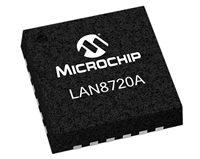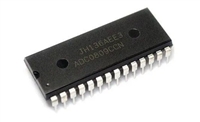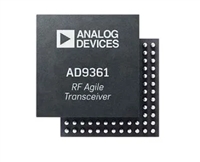APPLICATION NOTE
AN53
I/O Controls
The RC5051 Controller
In addition to the Voltage Identification, there are several sig-
nals that control the DC-DC converter or provide feedback from
the DC-DC converter to the CPU. They are Power-Good
(PWRGD), and Output Enable (OUTEN). These signals will be
discussed later.
The RC5051 is a programmable synchronous DC-DC
controller IC. When designed around the appropriate exter-
nal components, this device can be configured to deliver
more than 14.5A of output current. The RC5051 utilizes both
current-mode and voltage-mode PWM control to create an
integrated step-down voltage regulator.
RC5051 Description
Main Control Loop
Simple Step-Down Converter
Refer to the RC5051 Block Diagram illustrated in Figure 2.
The control loop of the regulator contains two main sections:
the analog control block and the digital control block. The
analog section consists of signal conditioning amplifiers
feeding into a set of comparators which provide the inputs to
the digital control block. The signal conditioning section
accepts inputs from the IFB (current feedback) and VFB
(voltage feedback) pins and sets up two controlling signal
paths. The voltage control path amplifies the difference
between the VFB signal and the voltage reference and pre-
sents the output to one of the summing amplifier inputs. The
current control path takes the difference between the IFB and
VFB pins and presents the resulting signal to another input
of the summing amplifier. These two signals are then
summed together with the slope compensation input from
the oscillator. This output is then presented to a comparator,
which provides the main PWM control signal to the digital
control block.
S1
L1
+
RL Vout
–
VIN
D1
C1
65-AP53-03
Figure 1. Simple Buck DC-DC Converter
For the purpose of understanding a buck converter, Figure 1
illustrates a step-down DC-DC converter with no feedback con-
trol. The operation of the basic step-down converter is the basis
for the design equations for the RC5051. Referring to Figure 1,
the basic operation begins by closing the switch S1. When S1 is
closed, the input voltage VIN is applied to inductor L1. The cur-
rent flowing in this inductor increases, and the increase is given
by the following equation:
The additional comparators in the analog control section set
the point at which the current limit comparator disables the
output drive signals to the external power MOSFETs.
(VIN – VOUT)TON
DIL = ----------------------------------------------
L1
where T is the time S1 is closed (the duty cycle is T
/ T ,
S
ON
ON
The digital control block takes the comparator inputs and the
main clock signal from the oscillator to provide the appropri-
ate pulses to the HIDRV and LODRV output pins. These
pins control the external power MOSFETs. The digital sec-
tion utilizes high speed Schottky transistor logic, allowing
the RC5051 to operate at clock speeds as high as 1MHz.
with T the switching period). When S1 opens, the diode D1
S
conducts the inductor current and the output current is delivered
to the load; the inductor current decrease is given by:
VOUT(TS – TON
)
DIL = -------------------------------------------
L1
where (T - T ) is the time during which S1 is open.
High Current Output Drivers
S
ON
The RC5051 contains two identical high current output
drivers that utilize high speed bipolar transistors in a push-
pull configuration. Each driver is capable of delivering 1A of
current in less than 100ns. Each driver’s power and ground
are separated from the chip’s power and ground for addi-
tional switching noise immunity.
By solving these two equations, we can arrive at the basic rela-
tionship for the output voltage of a step-down converter:
TON
----------
VOUT = VIN
TS
In order to obtain a more accurate approximation for V
, we
OUT
must also include the forward voltage V across diode D1 and
D
the voltage across the switch , V . After taking into account
SW
these factors, the new relationship becomes:
TON
----------
– VD
VOUT = (VIN + VD – VSW
)
TS
where V = is the voltage across the MOSFET in the on state,
SW
I
* R
.
L
DS,ON
3






 LAN8720以太网收发器:资料手册参数分析
LAN8720以太网收发器:资料手册参数分析

 SI2301 N沟道MOSFET:资料手册参数分析
SI2301 N沟道MOSFET:资料手册参数分析

 ADC0809逐次逼近寄存器型模数转换器:资料手册参数分析
ADC0809逐次逼近寄存器型模数转换器:资料手册参数分析

 AD9361捷变收发器:全面参数解析与关键特性概览
AD9361捷变收发器:全面参数解析与关键特性概览
